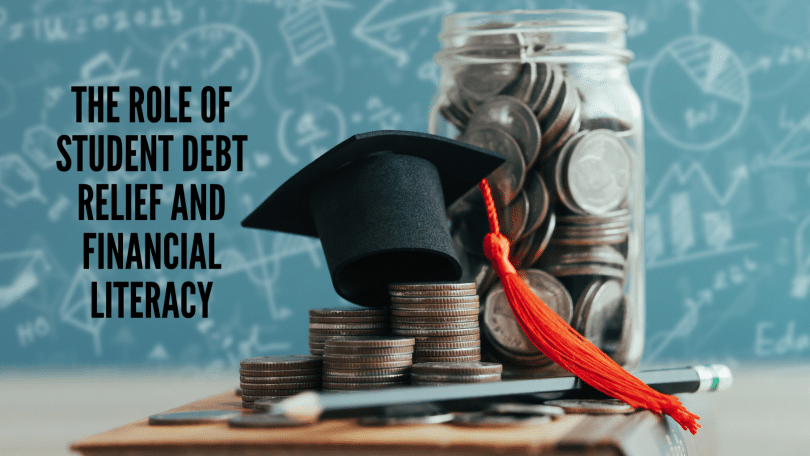Picture this: as you read these words, American students are drowning in a sea of debt. As of 2022, total student loan debt hit a staggering $1.75 trillion, surpassing both auto loans and credit cards to become the second-highest consumer debt category in the U.S. after mortgages.
For an entire generation already struggling with the soaring costs of healthcare, housing, childcare, and more in a vastly unequal economy, this student debt crisis serves as an anchor that drags millions down financially.
However, amidst the seemingly endless waves of dire statistics lies a lifeline that could change the tide – financial literacy. When paired with student debt relief programs, financial literacy equips borrowers with fundamental money management skills to avoid and overcome debt.
This article discusses how improving financial literacy and expanding student debt relief can create a multi-pronged solution.
Contents
- 1 The Soaring Costs of Higher Education
- 2 The Critical Role of Financial Literacy
- 3 Syncing Debt Relief and Financial Skills
- 4 Path Forward: Policy Reform & Grassroots Education
- 5 Strategies for Enhancing Financial Literacy
- 6 Policy Initiatives for Combating Student Debt through Financial Literacy:
- 7 Conclusion
- 8 FAQs
The Soaring Costs of Higher Education
Over the past 30 years, college tuition and fees have more than doubled at both public and private institutions. For the 2021-2022 academic year, average annual costs (including tuition, fees, room, and board) came out to
| Public 4-year institutions | $22,700 |
| Private nonprofit 4-year institutions | $53,800
|
This rapid increase in higher education costs has forced students to take on more debt. Among graduates of the Class of 2020, average student debt climbed to $30,030 per borrower – an increase of 20% from just a decade ago.
With ballooning debt and modest early-career salaries, borrowers struggle to keep up with payments. It’s no wonder over 10% of student borrowers default on loans within 3 years of entering repayment. And the ramifications of defaulting extend far beyond damaged credit scores to long-term financial distress.
Over the last 15 years, outstanding student loan debt has skyrocketed a staggering 170% to hit $1.75 trillion in 2022. This now constitutes the highest source of household debt outside of mortgages. For an entire generation already struggling financially amidst soaring costs of living, this mounting student debt burden serves as an anchor dragging millions down.
Michigan’s economy, in particular, relies heavily on manufacturing, specifically in the automotive industry. In recent years, it has seen growth in sectors such as technology, healthcare, and renewable energy.
Overall, Michigan’s economy has shown resilience but continued focus on innovation, education, and infrastructure is crucial for sustained growth and prosperity. Michigan debt relief programs offer valuable assistance to individuals struggling with financial burdens, paving the way toward financial stability and a brighter future.
Factors driving this exponential crisis include
Rising College Costs: Tuition and fees have more than doubled since the 1990s. State budget cuts for public universities shift the pricing burden onto families, while private institutions face little pricing regulation.
Predatory Lending Practices: As more students take on debt to bridge the college affordability gap, bad actors have seized the opportunity to offer private subprime loans featuring variable interest rates of up to 18% APR. These trap borrowers in endless interest-only payments without touching the principal.
Stagnant Early-Career Wages: Despite the premium commanded by college graduates in the job market, real wages for young adults have declined over the last 30 years. This economic squeeze means meager entry-level salaries barely cover necessities, let alone swelling student loan bills.
The consequences of this toxic combination include
- New graduates owe nearly $30,000 on average per borrower.
- Over a quarter of loans are delinquent or in default just 5 years into repayment.
- Borrowers’ inability to qualify for other loans to buy homes or cars, hampering economic productivity.
Without solutions, Generation Z and young millennials face limited social mobility and financial security, with seismic impacts on the nation’s economic future.
However, considering microfinance pros and cons, which fosters financial inclusion and entrepreneurship among underserved communities, and challenges such as high interest rates and over-indebtedness warrant careful consideration.
The Critical Role of Financial Literacy
Financial literacy refers to possessing the skills, knowledge, and confidence to manage personal finances through appropriate short and long-term decision-making. This includes rational goal-setting aligned with income and expense monitoring, utilizing credit responsibly, planning for major purchases and life events, and investing knowledgeably.
However, surveys reveal staggeringly low financial literacy among students:
- Only 17% of millennials demonstrate basic financial knowledge.
- Just 24% of millennials engage in financial planning.
- Just 43% of high schoolers demonstrate age-appropriate financial knowledge
- Fewer than 1 in 3 college students possess a basic understanding of financial concepts like interest compounding
- A mere 16% of college students correctly answered basic financial literacy quiz questions on topics like interest rates and inflation.
This knowledge gap has dire ramifications, evidenced by climbing student loan delinquency rates. Without grasping concepts like how interest accrues on unsubsidized loans during school or how to evaluate income-based repayment options, borrowers struggle to manage growing debt. Having access to financing options without the skills to wield them responsibly creates a ticking time bomb.
Thus, comprehensive financial education starting from K-12 emerges as a powerful mechanism to stem the student debt crisis – equipping youth to make prudent borrowing decisions to fund schooling and mapped career trajectories.
This lack of understanding creates vulnerability to poor or impulsive financial choices. Without recognizing the long-term impacts of loans, many bright-eyed freshmen sign up for more debt than necessary. And later down the road, limited budgeting abilities make managing repayments exceedingly difficult.
Thus, comprehensive financial education at every academic level emerges as a powerful mechanism to prevent the debt crisis from worsening and to provide solutions to existing problems.
Financial literacy provides the building blocks for individuals to make informed money management decisions aligned with both short and long-term life priorities. Core components include:
- Realistic budgeting accounting for income, expenses, and cash flow.
- Strategic use of lending options weighing interest rates and repayment terms.
- Planning and saving for major purchases and life events.
- Investing with a clear strategy and risk tolerance.
Syncing Debt Relief and Financial Skills
In recent years, mounting public pressure has led policymakers to establish various student debt relief programs including income-based repayment plans, loan consolidation/refinancing, loan forgiveness, and more. These directly alleviate borrowers’ burdens and even boost economic productivity by freeing up income for other purchases.
However, long-term success requires complementing temporary aid with enduring personal finance abilities that prevent repeat mistakes. Initiatives by educational institutions to integrate financial literacy into orientations, first-year curriculums, workshops, and courses have shown:
- Lower student loan default rates as borrowers better manage existing loans. Reduced reliance on private loans with higher interest rates by improving public loan understanding.
- Greater confidence in navigating complex repayment options like income-driven plans.
Without the basic ABCs of personal finance, students remain captive to debt without the tools to overcome financial hardship. Thus, comprehensive solutions call for integrating debt relief and financial literacy.
In recent years, escalating public scrutiny has spurred policymakers to create targeted student debt relief programs at both federal and state levels, including:
- Income-driven repayment (IDR) plans with reduced monthly bills based on wages.
- Consolidation/refinancing to combine loans under improved terms.
- Loan forgiveness for public/nonprofit employees after 10 years.
- Paused loan payments and 0% interest during the pandemic.
These interventions directly alleviate borrowers’ burdens. But long-term success requires complementing temporary aid with enduring personal finance skills that prevent repeat mistakes.
School-led initiatives to integrate financial literacy have shown a profound impact.
- New student orientation modules reduced borrowing by 23%.
- First-year seminars almost halved loan default rates after graduation.
- Targeted workshops enhanced confidence in navigating complex repayment options.
Equipping youth to make informed funding decisions and borrow only as needed reduces over-reliance on loans. Bolstering understanding of accumulating interest, loan terminology, credit scores, and repayment processes empowers better management. Financial literacy is not just a privileged bonus, but an essential prerequisite to ensure debt relief aids borrowers most in need.
Integrated, synchronized efforts across policymaking bodies and educational institutions can protect vulnerable student borrowers from predatory products and practices – instead fostering responsible money management for lifelong financial health.
Path Forward: Policy Reform & Grassroots Education
Tackling systemic issues plaguing college affordability remains imperative—but also highly complex, requiring years of coordinated reform across institutions and government agencies. In the meantime, equipping youth and families with financial decision-making skills can help prevent individual crises.
At the policy level, actions to spur progress include:
- Federal grants to fund state financial literacy education programs from K-12.
- Standardized financial literacy metrics and reporting requirements for colleges.
- Expanded federal loan counseling with integrated money management skills training.
Additionally, grassroots efforts make a difference through:
- Community workshops teaching practical budgeting and borrowing best practices.
- Peer mentoring programs that encourage open dialogue around financial challenges.
- Engaging online learning tools and apps catered to young adults.
While daunting statistics paint a picture of impending disaster, practical solutions exist to change students’ financial trajectories. Financial literacy serves as a critical line of defense when paired with student debt relief. By joining forces at policy and ground levels, we can stem the rising tide of debt for brighter financial futures.
Strategies for Enhancing Financial Literacy
With student debt’s economic chokehold intensifying, enhancing financial literacy should become a national imperative and coordinated priority across the education system. Schools need increased funding, accountability metrics, and evidence-based ways to foster money management skills, including:
K-12 Curriculum Integration
Starting financial education early allows foundational knowledge to accumulate across grades:
- Require stand-alone financial literacy courses at middle and high school levels
- Embed personal finance concepts into existing math courses
- Launch fintech workshops teaching budgeting/investing apps
Higher Ed Reform
Colleges serve as the last institutional touchpoint before students take on debt and enter the “real world”:
- Mandate loan/debt counseling for all first-years to inform borrowing
- Create peer financial advocate programs to share loan experiences
- Incentivize minors/certificates in financial planning
Policy Support
Top-down policies spur institutional buy-in for financial literacy:
- Standardized reporting requirements on financial education offerings.
- Tie federal funding to demonstrated money management competencies
- Train loan counselors to integrate financial advice with options.
With aligned efforts from grassroots community activists to the highest echelons of power, we can stem the student debt tide threatening to drown an entire generation, thus clearing the way for financial mobility.
Policy Initiatives for Combating Student Debt through Financial Literacy:
The burden of student debt continues to be a significant challenge for millions of students and graduates across the globe. As this issue deepens, there is an increasing recognition of the need for comprehensive strategies that not only address the symptoms of student debt but also tackle its root causes.
Central to these strategies is the implementation of policy initiatives aimed at enhancing financial literacy among students. By equipping students with the knowledge and skills to manage their finances effectively, these initiatives pave the way for a more sustainable solution to the student debt crisis.
Governments, educational institutions, and non-profit organizations are at the forefront of developing and implementing financial literacy programs. These initiatives range from mandatory financial education courses in high schools and universities to public awareness campaigns that demystify the terms and conditions of student loans.
Other strategies include integrating financial literacy into existing curriculum frameworks, offering personalized financial counseling sessions, and developing online resources and tools to help students make informed decisions about borrowing, spending, and saving.
Furthermore, policy initiatives are increasingly focusing on the accessibility of financial literacy resources to ensure that they reach a broad audience. This includes tailoring programs to meet the needs of diverse student populations, including those from low-income backgrounds, first-generation college students, and adult learners returning to education.
By acknowledging and addressing these disparities, policy initiatives can ensure that financial literacy education acts as a powerful tool in combating student debt, leveling the playing field for all students regardless of their socio-economic status.
Conclusion
Addressing both student debt relief and financial literacy is imperative for fostering a financially healthy society and ensuring equitable access to education. By implementing comprehensive strategies that alleviate the burden of student debt while simultaneously promoting financial education, policymakers and educators can empower individuals to make informed financial decisions, break cycles of debt, and pave the way for greater economic prosperity and social mobility.
FAQs
- What is student debt relief?
Student debt relief refers to various programs and strategies aimed at reducing the burden of student loan debt for borrowers. These can include loan forgiveness, repayment plans based on income, and refinancing options.
- How can financial literacy help manage student debt?
Financial literacy provides the knowledge and skills needed to make informed and effective decisions with financial resources, helping borrowers understand how to manage, repay, and minimize student loans effectively.
- What are the most common student loan forgiveness programs?
Common programs include the Public Service Loan Forgiveness (PSLF) program, Teacher Loan Forgiveness, and forgiveness options for borrowers on Income-Driven Repayment Plans after a certain period of payments.
- Can refinancing student loans save money?
Yes, refinancing can potentially lower interest rates, reduce monthly payments, and save money over the life of the loan, but it may also mean losing certain federal loan protections.
- What is an Income-Driven Repayment Plan?
Income-driven repayment Plans adjust your monthly student loan payment amount based on your income and family size, potentially offering more manageable payment terms and eventual loan forgiveness.
- How does one apply for student loan forgiveness?
The application process varies by program but generally involves completing specific forms and providing documentation to your loan servicer that proves eligibility based on the program’s requirements.
- What is the impact of student loans on credit scores?
Student loans can impact your credit score through factors like payment history and debt-to-income ratio. Consistent on-time payments can positively affect your score, while late payments can cause harm.
- Are private student loans eligible for forgiveness programs?
Most forgiveness programs are for federal student loans. Private student loans generally do not qualify for federal forgiveness programs, but some lenders may offer their relief options.
- What are the benefits of attending financial literacy workshops for students?
These workshops can improve understanding of personal finance, budgeting, saving, and debt management, equipping students with the tools to handle their finances wisely during and after college.
- How can budgeting help with student loan repayment?
Budgeting helps you track your spending, identify areas to cut back, and allocate more funds toward student loan payments, potentially speeding up the repayment process.
- What should be considered before taking out student loans?
Consider factors like the total cost of education, expected future earnings, loan terms and conditions, and alternative funding sources to minimize debt.
- How do student loans affect financial freedom after graduation?
Large student loan debts can limit financial freedom by impacting borrowers’ ability to save, invest, purchase a home, or make other significant financial decisions.
- What are the risks of defaulting on student loans?
Defaulting on student loans can lead to severe consequences, including damaged credit, wage garnishment, and the loss of eligibility for further aid and relief programs.
- Is it possible to cancel student loan debt in bankruptcy?
While challenging, it’s not impossible to discharge student loans in bankruptcy. Borrowers must prove that repaying the loans would cause undue hardship.
- Where can students and graduates find resources for managing student debt?
Resources can be found through the U.S. Department of Education’s website, non-profit organizations focused on student debt relief, financial literacy websites, and financial advisors specializing in student loans.







